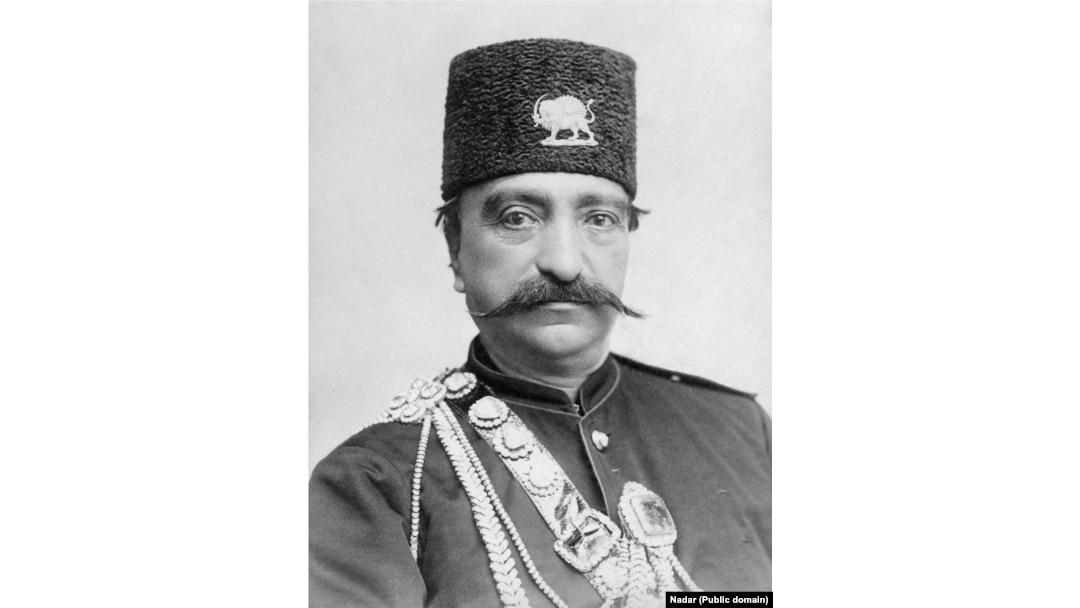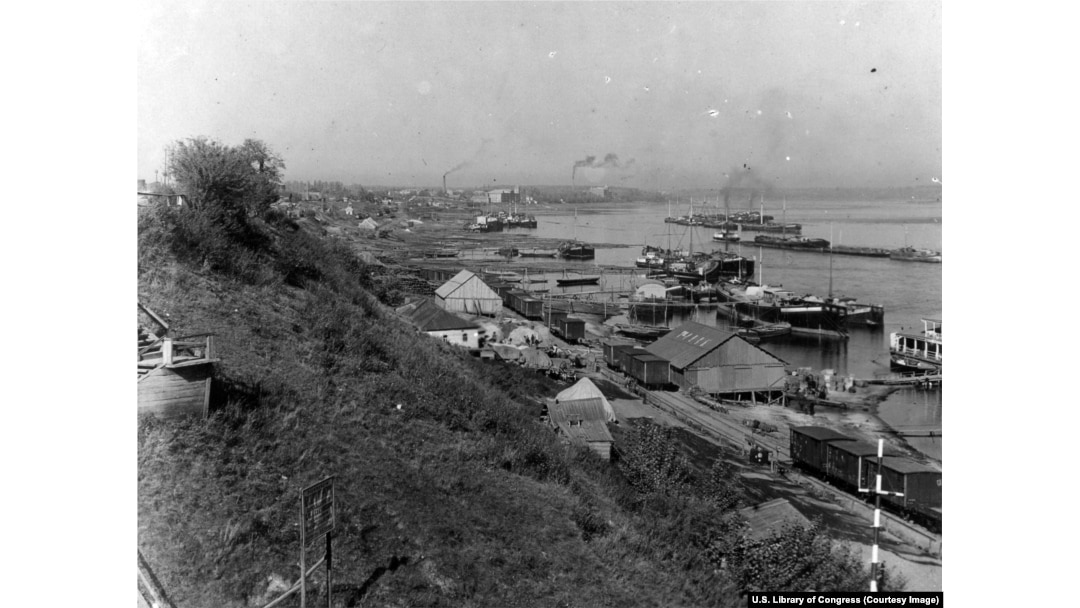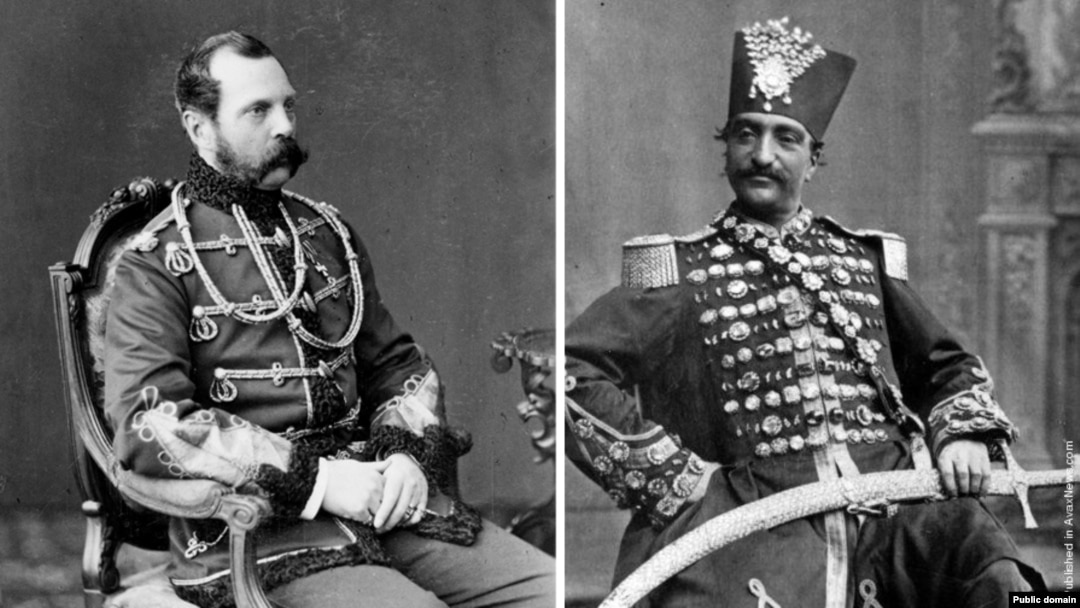In 1874, a travel diary of Iran’s ruler Naser al-Din Shah was published in English for the first time, offering a fascinating insight into the shah’s trip through Russia, Western Europe, and the Caucasus that had taken place the previous year. It was the first trip of its kind by an Iranian ruler.
Below, largely in the shah's own words, are details of the trip, which would play a part in transforming Iran. Photographs used in this story were taken in the places the shah visited at approximately the time he saw them.

Naser al-Din Shah
"Thanks be to God, we have escaped from the high sea and have entered a large river named the Volga, which has a great charm," Naser wrote of his first glimpses of the Russian Empire after traveling by ship across the Caspian Sea from Iran in May 1873. "This stream is very wide; so much so that…an ordinary musket ball would not carry from bank to bank."

A town on the Volga River in southern Russia
“In each village a church has been built, very fine and majestic. The occupation of the people of these villages is that of fishing," the shah noted in his first impressions of ordinary Russians.
As they steamed close to some of the villages, Naser said “the inhabitants flocked to the riverbank and cried out, 'Hurrah!'"
When the mayor of a Volga town brought out the traditional gifts of bread and salt, the shah says the date of his arrival was inscribed into the serving tray.
Fishermen process fish in a town on the Volga River.
From southern Russia, the shah and his retinue were transported by rail, which was apparently a novel experience for him.
A steam train on the Trans-Siberian Railway
“The pace of the train was such that we overtook the flying crows,” Naser wrote in wonder.
The shah apparently learned the vocabulary of the railroad for the first time in Russia.
“A ‘station’ is a place where the trains stop to have their wheels greased and where the passengers take coffee and refreshments,” he noted.
In another passage, he described a tunnel they passed through as a “hole in the mountain.”
The Bolshoi Theatre in Moscow
As the train neared Moscow, the formal aspects of the tour began, in which the shah and his entourage put on their dress uniforms and were shown the Kremlin, then presumably invited to the Bolshoi Theatre, where he witnessed ballet for the first time.
“The curtain rose and a strange world made its appearance. A large number of women set to dancing. This dancing and performance is called a ballet, i.e. a performance and dance without speaking."
The specifics of the art form, he wrote, were "not possible to describe.”
Tsar Aleksander II
In St. Petersburg, the shah’s travelogue becomes frustratingly diplomatic as he meets with Tsar Aleksander II, a man “tall of stature and majestic, who speaks with great gravity and walks with a stately gait.”
Conversations between the two sovereigns are clearly considered off-limits by the shah and referred to only in passing as “long and pleasant.” In fact, much hung on the interaction between the two rulers, whose countries had only recently reached a delicate peace after centuries of conflict over control of the Caucasus.
St. Isaac's Cathedral in St. Petersburg
In St. Petersburg, theater performances were apparently somewhat bawdier than the ballet that had enchanted the shah in Moscow. One performer, described as a “fat woman clothed in tights, with naked bosom and legs,” rode a bicycle around flaming bottles of wine set on the floor of the stage.
“Ultimately, she fell over from the vehicle to the floor and her skirts took fire,” the shah noted.
The fountains at Peterhof, just outside St. Petersburg
The Iranian ruler seemed especially taken with Peterhof, a royal residence outside St. Petersburg.
“It was a place like paradise,” the shah gushed amid a detailed description of the fountains and leafy pathways that stretch to the Gulf of Finland.
On May 29, the shah departed west and looped through today's Germany, Great Britain, France, Switzerland Italy, Greece, and Turkey before heading toward Georgia on his way back to Iran.
Poti
The shah’s arrival by ship off Poti, in today’s western Georgia, was marked by celestial drama when lightning struck the sea just a few meters from the royal boat, “with a roar equal to that of a thousand cannons.”
On shore in Georgia, the shah was greeted by “various tribes and nationalities” that included Circassians, Lezgins, Armenians, Georgians, and Daghestani Muslims, as well as Mingrelians, an ethnicity that fascinated the shah.
Mingrelian warriors
“This region is part of the country of the Open-Heads,” Naser wrote of the Mingrelians. “The whole of the inhabitants of the Open-Head country go bare-headed. Never do the women, men, or children adopt the practice of wearing hats or caps on their heads.”
In almost the next breath, the shah appeared to contradict that bare-headed claim by describing Mingrelian warriors as wearing “a red cloth round their heads by way of turban, a pistol, and a large knife in their sashes."
Their uniform he said, "thus resembled those of the Zouaves in France and of the tribes of Hindustan, but their muskets were needle guns made in the factory of Tula.”
Freedom Square in Tbilisi
The shah arrived by train to Tbilisi on August 29 and seemed to be pleasantly surprised by its appearance.
“Fifty years ago, this town was very wretched and filthy,” he claimed without specifying how he knew its condition before his own birth. “Now, by degrees, private houses and public buildings, schools and colleges, broad streets paved with stone are being constructed.”
Tbilisi after flooding
As in Poti, the shah was struck by Tbilisi's ethnic mix of “Persians, Georgians, Russians, Daghestanis, Circassians, Germans, Armenians.”
Then, as now, Georgian fruit stood out for its quality. The shah singled out watermelons, grapes, and pears, as well as the cucumbers of Tbilisi.
But setting off toward Baku, in today’s Azerbaijan, the shah paints a picture of sunbaked desolation on the road east.
“Once out of Tbilisi, there was not a single trace of the works of man on either side of our road: As far as the eye could penetrate, all were melancholy plains or brown mountains,” he wrote.
Baku
In the territory of today’s Azerbaijan, the shah apparently no longer felt the need for diplomatic tact, or was fed up with being on the road.
“Gardens surround the town of Ganja, but within it the houses are poor and miserable,” he complained.
The shah stayed in an apartment he described as “a very wretched tenement on the top of a hill.”
The waterfront of Baku
On his last landward leg home, the shah's patience seemed at an end.
“The whole road to Baku was dry and bad. In fact, a plain and mountains so dry and so wretched we had neither seen nor heard of. Our journey today was over a part of the country called the Burying Ground -- a fit name for such a region.”
The shah paused only briefly in Baku before boarding a ship for home.
The trip through several empires reportedly left a significant impression on the shah and was widely seen as a diplomatic success. Soon after his return to Iran, Naser began work on establishing a small railway near Tehran.


